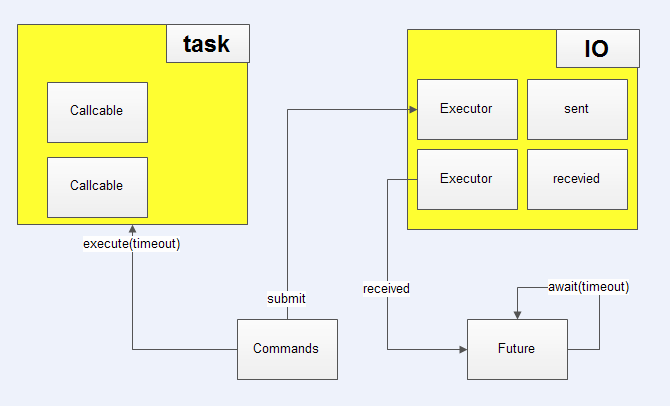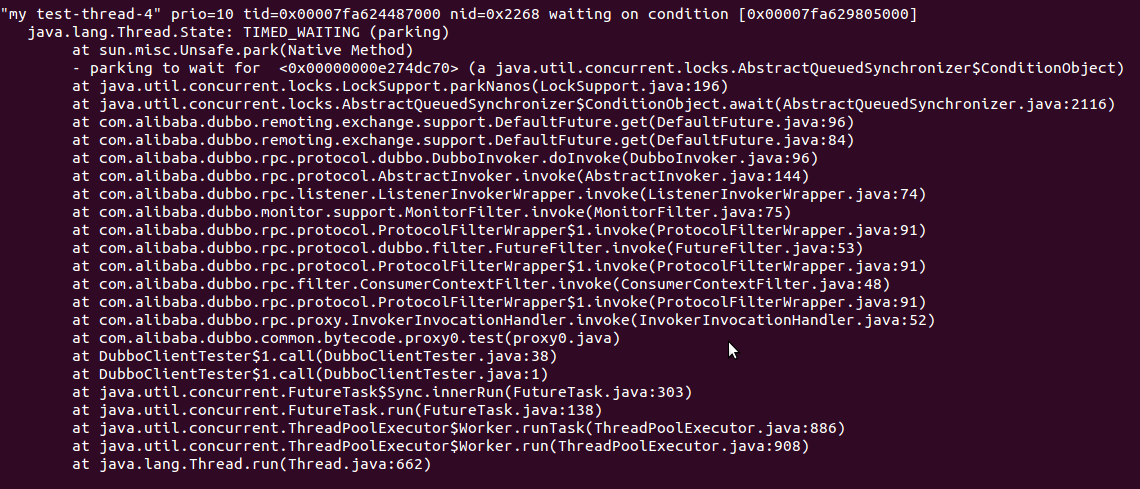dubbo是阿里巴巴开源的单一长连接服务框架,底层通信采用nio框架,支持netty,mina,grizzly,默认是netty。对dubbo比较感兴趣的是:
- client端的线程模型是什么样的?
传统的io client是请求应答模式,发送请求–>等待远程应答。dubbo底层是异步IO的,所有请求复用单一长连接,所以调用都不会阻在IO上,而是阻在Future超时wait上。
2. server端的线程模型是什么样的?
这个比较成熟了,现在一般的server都是基于nio,一批io thread负责处理io,一批worker thread负责处理业务。
一. 快速启动
学习dubbo最好的方式是快速运行起来,由于dubbo还是比较重量级的产品,之前遇到一些问题。
server端:
2
3
4
5
6
7
8
9
10
11
12
13
14
15
16
17
18
19
20
21
22
23
24
25
26
27
28
29
30
31
32
33
34
35
36
37
38
39
40
41
42
2
3import com.alibaba.dubbo.config.ApplicationConfig;
4import com.alibaba.dubbo.config.ProtocolConfig;
5import com.alibaba.dubbo.config.ServiceConfig;
6import com.duitang.dboss.client.test.BlogQueryService;
7import com.duitang.dboss.client.test.BlogQueryServiceImpl;
8
9public class DubboServerTester {
10
11 public static void main(String[] args) throws IOException {
12 BlogQueryService blogQueryService = new BlogQueryServiceImpl();
13 ApplicationConfig application = new ApplicationConfig();
14 application.setName("dubbo-test");
15
16 ProtocolConfig protocol = new ProtocolConfig();
17 protocol.setName("dubbo");
18 protocol.setPort(8989);
19 protocol.setThreads(200);
20
21 // RegistryConfig registry = new RegistryConfig();
22 // registry.setAddress("10.20.130.230:9090");
23 // registry.setUsername("aaa");
24 // registry.setPassword("bbb");
25
26 ServiceConfig<BlogQueryService> service = new ServiceConfig<BlogQueryService>(); // 此实例很重,封装了与注册中心的连接,请自行缓存,否则可能造成内存和连接泄漏
27 service.setApplication(application);
28
29 // service.setRegistry(registry);
30 service.setRegister(false);
31 service.setProtocol(protocol); // 多个协议可以用setProtocols()
32 service.setInterface(BlogQueryService.class);
33 service.setRef(blogQueryService);
34 service.setVersion("1.0.0");
35 // 暴露及注册服务
36 service.export();
37
38 System.out.println("Press any key to exit.");
39 System.in.read();
40 }
41}
42
2
2
client:
2
3
4
5
6
7
8
9
10
11
12
13
14
15
16
17
18
19
20
21
22
23
24
25
26
27
28
29
30
31
32
33
34
35
36
37
38
39
40
41
42
43
44
45
46
47
48
49
50
51
52
53
54
55
56
57
58
59
60
61
62
63
64
65
66
67
68
69
70
71
72
73
74
75
76
77
78
79
80
81
82
83
84
85
86
87
88
89
90
91
92
93
94
95
96
97
98
99
100
101
102
103
104
2import java.util.ArrayList;
3import java.util.List;
4import java.util.concurrent.Callable;
5import java.util.concurrent.ExecutionException;
6import java.util.concurrent.ExecutorService;
7import java.util.concurrent.Executors;
8import java.util.concurrent.Future;
9import java.util.concurrent.ThreadFactory;
10import java.util.concurrent.atomic.AtomicInteger;
11
12import com.alibaba.dubbo.config.ApplicationConfig;
13import com.alibaba.dubbo.config.ReferenceConfig;
14import com.duitang.dboss.client.test.BlogQueryService;
15
16public class DubboClientTester {
17
18 public static void main(String[] args) throws InterruptedException, IOException {
19 ApplicationConfig application = new ApplicationConfig();
20 application.setName("dubbo-test");
21
22 ReferenceConfig<BlogQueryService> reference = new ReferenceConfig<BlogQueryService>();
23 reference.setUrl("dubbo://127.0.0.1:8989/com.duitang.dboss.client.test.BlogQueryService");
24 reference.setTimeout(500);
25 reference.setConnections(10);
26 reference.setApplication(application);
27 reference.setInterface(BlogQueryService.class);
28 reference.setVersion("1.0.0");
29 final BlogQueryService blogQueryService = reference.get();
30
31 long begin = System.currentTimeMillis();
32 System.out.println(blogQueryService.test());
33 long end = System.currentTimeMillis();
34 System.out.println(" cost:" + (end - begin));
35
36 ExecutorService es = Executors.newFixedThreadPool(50, new NamedThreadFactory("my test"));
37 List<Callable<String>> tasks = new ArrayList<Callable<String>>();
38 for (int i = 0; i < 100000; ++i) {
39 tasks.add(new Callable<String>() {
40
41 @Override
42 public String call() throws Exception {
43 System.out.println("run");
44 System.out.println(blogQueryService.test());
45 System.out.println("run success");
46 return null;
47 }
48 });
49 }
50 List<Future<String>> futurelist = es.invokeAll(tasks);
51 for (Future<String> future : futurelist) {
52 try {
53 String result = future.get();
54 } catch (ExecutionException e) {
55 e.printStackTrace();
56 }
57 System.out.println("------------------------------------------------------------------------------------------------------------------------------------------------\r\n");
58 }
59 es.shutdown();
60 System.out.println("end");
61 System.in.read();
62 }
63
64 static class NamedThreadFactory implements ThreadFactory {
65
66 private static final AtomicInteger POOL_SEQ = new AtomicInteger(1);
67
68 private final AtomicInteger mThreadNum = new AtomicInteger(1);
69
70 private final String mPrefix;
71
72 private final boolean mDaemo;
73
74 private final ThreadGroup mGroup;
75
76 public NamedThreadFactory(){
77 this("pool-" + POOL_SEQ.getAndIncrement(), false);
78 }
79
80 public NamedThreadFactory(String prefix){
81 this(prefix, false);
82 }
83
84 public NamedThreadFactory(String prefix, boolean daemo){
85 mPrefix = prefix + "-thread-";
86 mDaemo = daemo;
87 SecurityManager s = System.getSecurityManager();
88 mGroup = (s == null) ? Thread.currentThread().getThreadGroup() : s.getThreadGroup();
89 }
90
91 public Thread newThread(Runnable runnable) {
92 String name = mPrefix + mThreadNum.getAndIncrement();
93 Thread ret = new Thread(mGroup, runnable, name, 0);
94 ret.setDaemon(mDaemo);
95 return ret;
96 }
97
98 public ThreadGroup getThreadGroup() {
99 return mGroup;
100 }
101
102 }
103}
104
2
2
- 通过setUrl("")来实现远程服务直连。
- 需要注意的是默认connection只有一个,可以通过setConnections()来指定connection pool。在高负载环境下,nio的单连接也会遇到瓶颈,此时你可以通过设置连接池来让更多的连接分担dubbo的请求负载,从而提高系统的吞吐量。”
二. 代码流程
这里重点分析一下client的调用过程,client调用分为三个部分:
1). 初始化,建立连接。
2). 发送请求。
3). 等待远程应答。
(一).初始化
- DubboProtocol.initClient()
- Exchangers.connect(URL url, ExchangeHandler handler)
- Exchangers.getExchanger(url).connect(url, handler)
- HeaderExchanger.connect(URL url, ExchangeHandler handler)
- return new HeaderExchangeClient(Transporters.connect(url, new DecodeHandler(new HeaderExchangeHandler(handler))));
- Transporters.getTransporter().connect(URL url, ChannelHandler handler)
- NettyTransporter.connect(URL url, ChannelHandler listener)
- new NettyClient(url, listener) //timeout默认值:timeout=1000;connectTimeout=3000;
- NettyClient.doOpen() //创建netty的ClientBootstrap
bootstrap = new ClientBootstrap(channelFactory);
bootstrap.setOption("keepAlive", true);
bootstrap.setOption("tcpNoDelay", true);
bootstrap.setOption("connectTimeoutMillis", getTimeout()); //注意:此timeout是timeout,而非connectTimeout
10. AbstractClient.connect()
11. NettyClient.doConnect() //如果远程地址无法连接,抛出timeout异常流程结束。
ChannelFuture future = bootstrap.connect(getConnectAddress());
boolean ret = future.awaitUninterruptibly(getConnectTimeout(), TimeUnit.MILLISECONDS);
(二).发送请求
1.DubboInvoker.doInvoke(Invocation invocation) //currentClient.request(invocation, timeout).get()
2.HeaderExchangeClient.request(invocation, timeout)
3.HeaderExchangeChannel.request(Invocation invocation,timeout)
4.AbstractPeer.send(Request request)
5.NettyChannel.send(Object message, boolean sent)
6.NioClientSocketChannel.write(message)
7.NettyHandler.writeRequested(ChannelHandlerContext ctx, MessageEvent e)
8.AbstractPeer.sent(Channel ch, Request request)
(三).等待远程应答
在调用DubboInvoker.doInvoke(Invocation invocation)中实际是调用currentClient.request(invocation, timeout).get(),此方法会返回DefaultFuture,调用get方法会阻塞直到超时,在阻塞的同时netty的io线程会接收到远程应答,如果收到响应会产生io事件调用NettyHandler.messageReceived。
1.NettyHandler.messageReceived(ChannelHandlerContext ctx, MessageEvent e)
2.AbstractPeer.received(Channel ch, Object msg)
3.MultiMessageHandler.received(Channel channel, Object message)
4.AllChannelHandler.received(Channel channel, Object message)
5.DecodeHandler.received(Channel channel, Object message)
6.HeaderExchangeHandler.received(Channel channel, Object message)
7.DefaultFuture.received(Channel channel, Response response) //注意是static方法
DefaultFuture future = FUTURES.remove(response.getId());
if (future != null) {
future.doReceived(response);
}
三. dubbo client的核心
我认为dubbo client的核心在DefaultFuture。所以远程调用都不会阻在IO上,而是阻在Future超时wait上,下面忽略掉远程调用把future抽取出来。

下面是代码实现
2
3
4
5
6
7
8
9
10
11
12
13
14
15
16
17
18
19
20
21
22
23
24
25
26
27
28
29
30
31
32
33
34
35
36
37
38
39
40
41
42
43
44
45
46
47
48
49
50
51
52
53
54
2
3import java.util.concurrent.Callable;
4import java.util.concurrent.ExecutionException;
5import java.util.concurrent.ExecutorService;
6import java.util.concurrent.Executors;
7import java.util.concurrent.Future;
8import java.util.concurrent.atomic.AtomicLong;
9
10public class Commands {
11
12 private ExecutorService senders = Executors.newCachedThreadPool();
13 private ExecutorService receviers = Executors.newCachedThreadPool();
14 private AtomicLong counter = new AtomicLong();
15
16 public CommandResponse execute(Callable<Object> task, int timeout) {
17 Future<Object> result = senders.submit(task);
18 long id = counter.getAndIncrement();
19 CommandFuture commandFuture = new CommandFuture(id);
20 receviers.submit(new ReceiveWorker(id, result));
21 return commandFuture.get(timeout);
22 }
23
24 static class ReceiveWorker implements Runnable {
25
26 private Future<Object> result;
27 private Long id;
28
29 public ReceiveWorker(Long id, Future<Object> result){
30 super();
31 this.result = result;
32 this.id = id;
33 }
34
35 @Override
36 public void run() {
37 try {
38 Object obj = result.get();
39 CommandFuture.received(new CommandResponse(id, obj));
40 } catch (InterruptedException e) {
41 e.printStackTrace();
42 } catch (ExecutionException e) {
43 e.printStackTrace();
44 }
45 }
46 }
47
48 public void shutdown() {
49 senders.shutdown();
50 receviers.shutdown();
51 }
52}
53
54
2
3
4
5
6
7
8
9
10
11
12
13
14
15
16
17
18
19
20
21
22
23
24
25
26
27
28
29
30
31
32
33
34
35
36
37
38
39
40
41
42
43
44
45
46
47
48
49
50
51
52
53
54
55
56
57
58
59
60
61
62
63
64
65
66
67
68
69
70
71
72
73
74
75
76
77
78
79
80
2
3import java.util.Map;
4import java.util.concurrent.ConcurrentHashMap;
5import java.util.concurrent.TimeUnit;
6import java.util.concurrent.locks.Condition;
7import java.util.concurrent.locks.Lock;
8import java.util.concurrent.locks.ReentrantLock;
9
10public class CommandFuture {
11
12 private final Lock lock = new ReentrantLock();
13
14 private final Condition done = lock.newCondition();
15
16 private CommandResponse response;
17
18 private static final Map<Long, CommandFuture> FUTURES = new ConcurrentHashMap<Long, CommandFuture>();
19
20
21 public CommandFuture(Long id){
22 FUTURES.put(id, this);
23 }
24
25 public boolean isDone() {
26 return response != null;
27 }
28
29 public CommandResponse get(int timeout) {
30
31 if (!isDone()) {
32 long start = System.currentTimeMillis();
33 lock.lock();
34 try {
35 while (!isDone()) {
36 done.await(timeout, TimeUnit.MILLISECONDS);
37 if (isDone() || System.currentTimeMillis() - start >= timeout) {
38 break;
39 }
40 }
41 } catch (InterruptedException e) {
42 throw new RuntimeException(e);
43 } finally {
44 lock.unlock();
45 }
46 if (!isDone()) {
47 throw new TimeoutException("timeout");
48 }
49 }
50 return response;
51 }
52
53 public void doReceived(CommandResponse response) {
54 lock.lock();
55 try {
56 this.response = response;
57 if (done != null) {
58 done.signal();
59 }
60 } finally {
61 lock.unlock();
62 }
63
64 }
65
66 public static void received(CommandResponse response) {
67 try {
68 CommandFuture future = FUTURES.remove(response.getId());
69 if (future != null) {
70 future.doReceived(response);
71 } else {
72 System.out.println("some error!");
73 }
74 } finally {
75 // CHANNELS.remove(response.getId());
76 }
77 }
78}
79
80
2
3
4
5
6
7
8
9
10
11
12
13
14
15
16
17
18
19
20
21
22
23
24
25
26
27
28
29
30
31
32
33
34
35
36
37
38
39
40
41
42
43
44
45
46
47
48
49
50
51
52
53
54
2
3import java.util.concurrent.Callable;
4import java.util.concurrent.ExecutionException;
5import java.util.concurrent.ExecutorService;
6import java.util.concurrent.Executors;
7import java.util.concurrent.Future;
8import java.util.concurrent.atomic.AtomicLong;
9
10public class Commands {
11
12 private ExecutorService senders = Executors.newCachedThreadPool();
13 private ExecutorService receviers = Executors.newCachedThreadPool();
14 private AtomicLong counter = new AtomicLong();
15
16 public CommandResponse execute(Callable<Object> task, int timeout) {
17 Future<Object> result = senders.submit(task);
18 long id = counter.getAndIncrement();
19 CommandFuture commandFuture = new CommandFuture(id);
20 receviers.submit(new ReceiveWorker(id, result));
21 return commandFuture.get(timeout);
22 }
23
24 static class ReceiveWorker implements Runnable {
25
26 private Future<Object> result;
27 private Long id;
28
29 public ReceiveWorker(Long id, Future<Object> result){
30 super();
31 this.result = result;
32 this.id = id;
33 }
34
35 @Override
36 public void run() {
37 try {
38 Object obj = result.get();
39 CommandFuture.received(new CommandResponse(id, obj));
40 } catch (InterruptedException e) {
41 e.printStackTrace();
42 } catch (ExecutionException e) {
43 e.printStackTrace();
44 }
45 }
46 }
47
48 public void shutdown() {
49 senders.shutdown();
50 receviers.shutdown();
51 }
52}
53
54
下面是jstack

